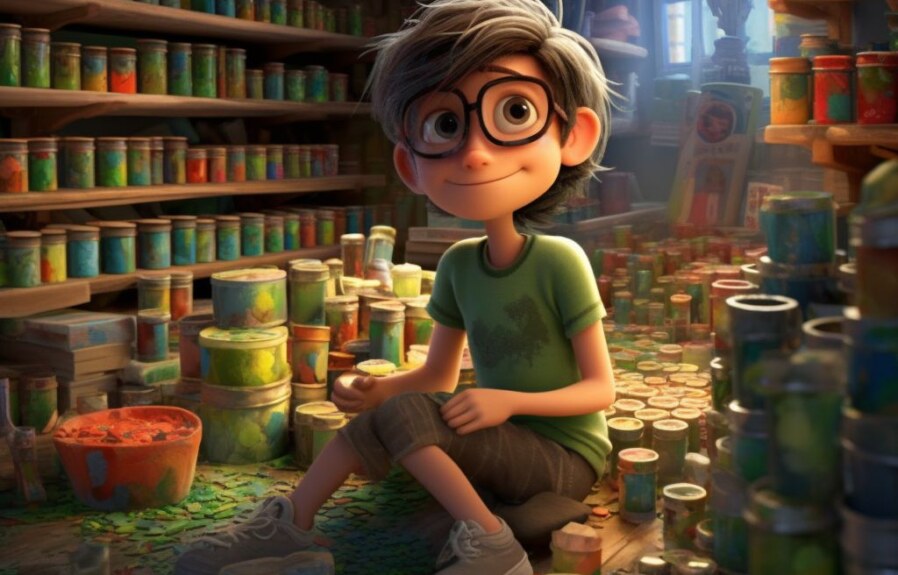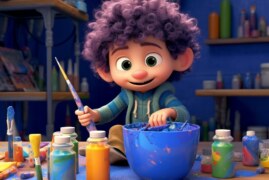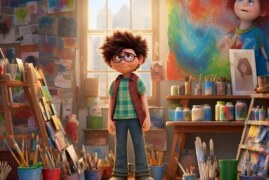Whether you’re an art student or an aspiring artist, you know that colors can make or break a piece of art. Dark green, in particular, is a color that exudes sophistication and depth. But what if you don’t have that exact shade on your palette? Don’t worry – you can easily learn how to make dark green with just a few simple steps. In this article, we’ll guide you through different techniques to achieve the perfect dark green for your next masterpiece. So get your brushes and paints ready, and let’s dive into the world of art color theory!
1. Understanding the Theory of Color Mixing: Why Dark Green is Different
Before diving into the process of making dark green, it’s important to have a basic understanding of color theory. All colors are the result of the interaction between light and our eyes, but when it comes to creating colors with paint, we are dealing with pigments. Pigments interact differently than light, and this is why dark green is different from simply mixing blue and yellow.
Green falls in between blue and yellow on the color spectrum, which means it is made up of equal parts of these two colors. However, to create a dark green color, we need to understand the concept of value. Value refers to the lightness or darkness of a color. Adding black to a pure green color will change its value, making it darker. But adding black to a mixture of blue and yellow will not result in the same shade of dark green, because the value of blue and yellow are different.
This is why essential pigments for creating dark green are crucial. A blue and yellow pigment that are both high in chroma (intensity of color) will result in a more vibrant dark green than pigments with low chroma. It’s also important to consider the transparency of the pigments; transparent pigments will allow light to reflect and create richer colors, while opaque pigments will result in a less subtle color. Understanding the nuances of how pigments interact will allow for more control in achieving the exact shade of dark green desired.
2. The Basic Ingredients: Essential Pigments for Making Dark Green
How to Make Dark Green
To make dark green, you need to understand the basic principles of color mixing. Green is a secondary color obtained by mixing yellow and blue. However, if you mix equal parts of yellow and blue, you’ll get a bright, almost fluorescent green color, which is not what you want for making dark green. Adding a darker hue to the mix is essential to achieve the desired effect.
To create a deep and rich shade of green, mix blue with a darker pigment such as black or burnt umber. The amount of black or burnt umber you add depends on the shade of green you want to achieve. It’s best to start with small amounts and add more as needed. If you add too much, you will end up with a dull and muddy green.
When choosing pigments, it’s important to consider the type of paint you’ll be using. Oil paints have a different pigment concentration than watercolors or acrylics. For oil painting, an excellent pigment for creating dark green is Pthalo green, which is a mixture of blue and green pigments. It’s highly concentrated, so use it sparingly. For watercolors, on the other hand, Ultramarine blue and Hooker’s green are the go-to pigments for creating dark green.
Remember that the quality of pigments you use affects the final result, so invest in quality paints if possible. With the right pigments and an understanding of color mixing, making dark green should be easy and enjoyable.
3. The Role of Toning: How to Create Subtle and Unique Shades of Dark Green
One of the most exciting aspects of creating art is the ability to experiment with color and create unique shades and tones that are entirely your own. When it comes to making dark green, toning is an essential factor that can take your color mixing skills to the next level. By adding a range of different colors, you can create subtle and unique shades of dark green that add depth and complexity to your work.
1. Using Complementary Colors
One of the most effective ways to tone dark green is to use its complementary color, which is red. By adding tiny amounts of red to your mix, you can create a more muted, earthy tone that is perfect for landscapes and natural scenes. Alternatively, you can add more red to create a bolder, more vibrant green that is perfect for abstract work or floral compositions.
2. Playing with Warm and Cool Colors
Another way to create unique shades of dark green is to play with warm and cool colors. Adding warmer tones like yellows or oranges can create a more earthy and natural green, while adding cooler blues or purples can create a more mysterious and moody tone.
3. Experimenting with Metallics
Finally, for a more dramatic effect, consider experimenting with metallic tones like gold or silver. These colors can add a shimmer and shine to your dark green mix, creating a unique and eye-catching shade that stands out from the crowd.
Overall, toning is a critical factor in creating subtle and unique shades of dark green that add depth and complexity to your artwork. With a little experimentation and some careful color mixing, you can create a palette of stunning greens that are entirely your own.
4. The Importance of Consistency: Tips for Achieving Even and Smooth Dark Green
Achieving consistency when making dark green is crucial to ensure even and smooth color on your canvas. Inconsistent mixing can result in a mottled and uneven appearance, which can be distracting to the viewer.
Tip #1: Use Exact Measurments
The first step to achieving consistent dark green is to measure your pigments precisely. Unmeasured pigment can result in unpredictable color, especially if you are mixing by eye. Measuring using a dropper or gram scale ensures that the ratio of pigment to binder is consistent, resulting in a uniform mixture.
Tip #2: Mix Thoroughly
Mixing thoroughly is essential to ensure even pigment distribution. Mix the pigments and binder for at least five minutes to ensure that the pigment is uniformly dispersed in the binder. You can also try using a palette knife or spatula to break up any clumps that might form while mixing, ensuring a smooth and even texture.
Tip #3: Test Your Mixture
Before applying your dark green to your painting, test it on a separate piece of paper or canvas to ensure that the color and consistency are what you desire. You can adjust the color by adding more pigment, and you can adjust the consistency by adding more binder or thinner.
By following these tips, you can achieve consistent and smooth dark green, ensuring that your paintings are professional and visually pleasing.
5. Experimenting with Dark Green: How to Customize and Personalize Your Palette
Once you have successfully created your basic shade of dark green, it’s time to experiment and customize your palette. Here are a few tips to get you started:
1. Adding White
Mixing white with dark green can create a range of lighter shades, perfect for highlighting and creating depth in your artwork. Experiment with different ratios of white and Dark Green Pigment to find the perfect shade for your piece.
2. Creating a Gradient
Begin with your darkest shade of dark green, then gradually add more and more white pigment to create a gradient effect. This technique is perfect for creating a background or a sky in your artwork.
3. Mixing with Other Colors
Dark green can be mixed with other colors to create unique and personalized shades. For example, mixing dark green with yellow will result in a bright lime green, while mixing it with blue will create a more muted shade. Experiment with different color combinations to find the perfect shade for your piece.
Remember, the key to successful experimentation with color is to keep notes on the ratios and combinations you use. This will help you replicate successful color combinations in the future.
6. Advanced Techniques: Combining Dark Green with Other Colors for Stunning Effects
Once you have mastered the art of creating dark green, it’s time to experiment and push your boundaries. Combining dark green with other colors can produce some stunning effects that will bring your artwork to life. In this section, we will explore some advanced techniques for combining dark green with other colors to enhance its beauty and impact.
Complimentary Colors
One way to create stunning effects with dark green is to pair it with its complimentary colors. Complimentary colors are opposite each other on the color wheel, and when used together, they create a strong contrast. The complimentary color of dark green is red. When combined, they create a powerful and striking effect. For example, using red and dark green in equal amounts can create a beautiful and vibrant composition.
Analogous Colors
Another technique is to combine dark green with analogous colors. Analogous colors are next to each other on the color wheel and when used together, they create a harmonious and subtle effect. Using analogous colors can help you to create a more cohesive and balanced composition. Combining dark green with blues and yellows, for instance, can produce a harmonious and peaceful effect.
Triadic Colors
A third technique is to use triadic colors. Triadic colors are three colors that are equally spaced apart on the color wheel. These colors, when used together, create a dynamic and visually pleasing effect. Combining dark green with violet and orange, for example, can create an eye-catching and energetic composition. However, be careful when combining triadic colors as they can quickly become overwhelming if not used in the right proportions.
In conclusion, combining dark green with other colors can produce some stunning effects that will significantly enhance your artwork. By using complimentary, analogous or triadic colors, you can create dynamic compositions that will attract the viewer’s attention. Remember to experiment and have fun with your colors, and always try to achieve a harmonious balance between them.
7. Storing and Using Your Dark Green Paint: Best Practices for Optimal Results
Explanation: Keeping your dark green paint safe and ensuring its longevity is important for maintaining its quality and effectiveness. In this section, we will give you tips on storing and using your dark green paint for the best results.
Storing Your Dark Green Paint: To ensure the longevity of your dark green paint, it is essential to store it properly. Store your paint in a cool and dry area, away from direct sunlight, which can affect the quality of the paint. Close the lid tightly after each use to prevent the paint from drying out. You can also add a drop or two of water to the paint to keep it moist. Make sure to label your paint containers properly to avoid confusion.
Using Your Dark Green Paint:
Before using your dark green paint, it is essential to prepare your painting surface. Ensure that the surface is clean and dry. Also, make sure that your brushes and painting tools are clean and free from dirt and debris.
When applying your dark green paint, use thin, even layers to achieve a smooth and consistent application. You can also mix your dark green paint with other colors to create unique and customized shades.
Tips: Always shake the paint container before use to ensure that the pigment is properly mixed. Additionally, use a paint palette or tray to avoid wasting your paint and to maintain consistency in your color. When finished painting, clean your brushes and tools properly using water and soap to prevent the paint from drying out and damaging the bristles.
By following these best practices, you can ensure that your dark green paint stays fresh and vibrant for your future artistic endeavors.
People Also Ask
How do you make dark green with paint?
To make dark green with paint, mix blue and yellow paint in a 2:1 ratio. Darken the color with black or mix in a little bit of red for a warmer tone.
How do you make dark green icing?
To make dark green icing, start with a base of green food coloring and add a small amount of black food coloring. Mix thoroughly and adjust as needed until you have reached your desired shade.
What colors make a forest green?
To make forest green, mix blue and yellow in equal parts. Then add a small amount of black until you get the desired shade.
How do you make dark green soap?
To make dark green soap, add green colorant to your soap base and gradually add black colorant until you reach your desired shade. You can also add a hint of blue for a more vibrant color.
What colors make lime green?
To make lime green, mix yellow and green paint in a 1:1 ratio. Adjust the color with more yellow or green depending on the desired shade.
Conclusion
There are many ways to make dark green depending on your needs. Mix blue and yellow paint or food coloring in a 2:1 ratio, and darken with black or red for a warmer tone. For a forest green shade, mix blue and yellow in equal parts and add black. Adjust your green color with black or blue to create the perfect shade for your project.



